Global defence spending increased by 9% to a record $2.2tn during 2023 driven by heightened geopolitical tensions caused by Russia’s invasion of Ukraine, according to an annual assessment by a military thinktank.
The International Institute of Strategic Studies added that it expected budgets to increase further in 2024 as the war continued into a third year and international uncertainty spread across the Middle East in the wake of the Israel-Gaza war.
Bastian Giegerich, the thinktank’s director general, described the near-double-digit uplift as reflecting “a deteriorating security landscape”. Russian and Ukrainian military spending soared, as well as western aid to Kyiv.
Ukraine’s defence budget increased nearly nine times to $31.1bn during 2023, a figure that excludes foreign donations, while Russia lifted its military expenditure in 2023 to $108.5bn and has further increases in the pipeline.
Moscow’s official defence budget was up by more than 60% in 2024 Giegerich said, meaning that Russian “total military spending now represents one third of its national budget and will now reach 7.5% of GDP, signalling the focus on its war effort”.
Russia had sustained heavy losses on the battlefield during 2023, he added, losing an estimated 1120 main battle tanks and about 2,000 other armoured fighting vehicles.
“To put that into perspective Russia’s battlefield tank losses are greater than the number it had when it launched in 2022,” Giegerich added, but said Moscow had been able to replenish numbers at a rate of 100 tanks a month, although their quality was lower, partly because many were taken out of storage.
Overall, Giegerich estimated that Russia would be able, at current rates, to sustain its tank force “for about two to three more years”..
Ukraine had also sustained heavy losses in tanks and other military equipment but these had so far been made good by western gifts. But with Republicans blocking the passage of a $61bn military aid package passed by the Senate through the House, Giegerich said the west needed to decide what its aims were in supporting Kyiv.
“Western governments find themselves once again in a position where they must decide whether to furnish Kyiv with enough weapons to deliver a decisive blow rather than enough merely not to lose,” he added.
Israel’s four-month-long assault of Hamas in Gaza in response to the 7 October attack had generated significant civilian casualties that have “raised questions about the execution of the operation and feasibility of its overall objective”, Giegerich said.
The director general estimated that Hamas casualties amounted to “between 20% and 30% of the total number of fighters” and the return of fighting squads to areas of northern Gaza attacked early in the war demonstrated “the difficultly of Israel of meeting its maximalist objective of destroying Hamas”.
It was also unclear if three rounds of bombing by the US and UK on Houthi targets in Yemen had significantly degraded the rebel group’s ability to strike at shipping in the Red Sea, partly because drone and missile launchers were easily hidden.
The bombing campaign “hasn’t yet fully delivered”, said Nick Childs, an IISS maritime security analyst. He added that there were “question marks over whether there’s a more sporadic threat” or whether the Houthis were trying to stockpile arms. Confidence among merchant shipping companies had not returned either, he added.
Overall, the US remains easily the largest global military spender, with a budget of $905.5bn in 2023, in dollar terms more than the next 15 countries combined, including second-placed China on $219.5bn and Russia, which is third.
Britain is ranked fifth globally, despite recent concerns about the ability of its army to fight a major war, ahead of Germany in seventh and France eighth. All Nato members in Europe have spent 32% more on defence since 2014, although only 10 of them spend more than 2% of GDP, according to alliance data.
